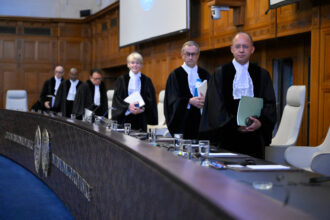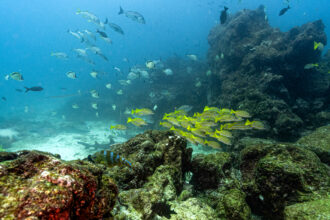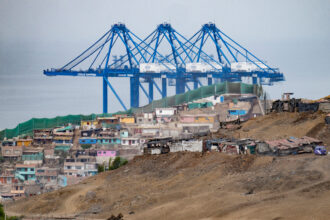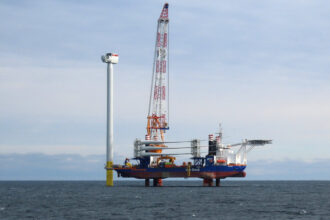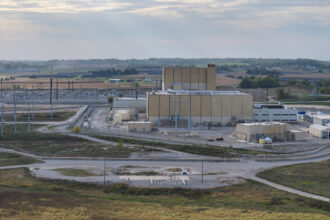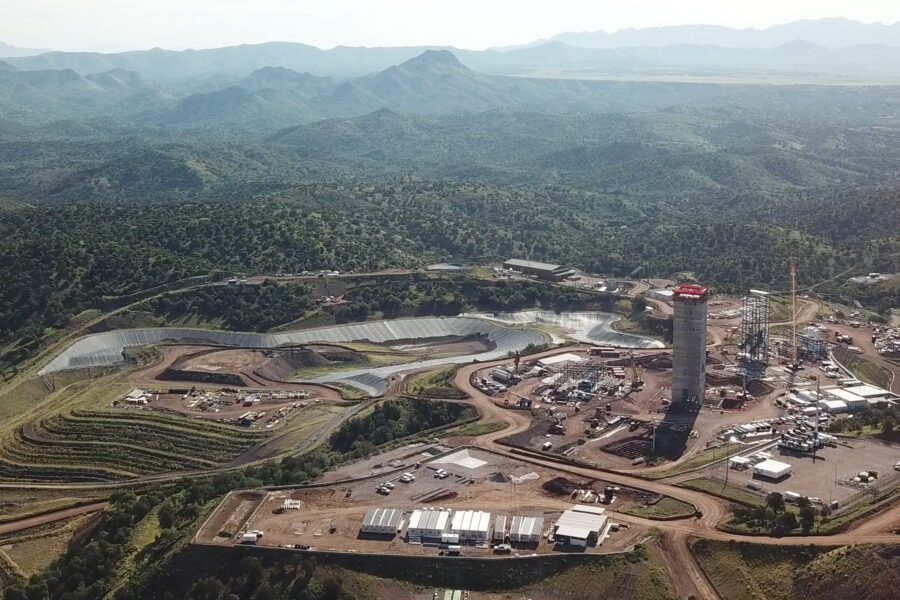As world leaders conclude the United Nations’ annual climate talks in Belém, Brazil— a summit meant to accelerate global action on phasing out fossil fuels—the Brazilian government is facing mounting criticism over its recent decision to authorize offshore drilling for oil near the Great Amazon Reef System.
This unique and understudied marine habitat makes up one of the largest reefs in Brazil. Some scientists estimate it may span at least 20,000 square miles, though less than 5 percent of the ecosystem has been mapped. Until recently, some people doubted its existence.
“It’s a big debate even nowadays. People don’t believe the reef exists,” said Fabiano Thompson, an oceanographer and professor at Federal University of Rio de Janeiro.
Much of the reef lies hidden beneath the turbulent, sediment and nutrient-filled waters pouring from the Amazon River into the Atlantic off the coast of Brazil’s northern state of Amapá in an area known in Portuguese as the Foz do Amazonas Basin, or the Mouth of the Amazon. Its location and notoriously strong currents make it very difficult to access.
Thompson is one of the few people who have seen the reef up close. In 2017, he joined a scientific expedition aboard Greenpeace’s ship, the Esperanza, and descended more than 600 feet underwater in a two-person submersible to explore the reef. That mission produced the first-ever photographs of the ecosystem.
“I was glad because we could show the existence of the reef,” said Thompson. “I knew that would have an impact.”
Far from a typical shallow coral reef, this deep, low-light ecosystem, known as a mesophotic reef, is largely composed, not of corals, but of vast mounds of rock-like red algae called rhodoliths. These living boulders serve as anchors for a variety of multi-colored pink, white and yellow sponges, as well as some coral species like black corals, known for their hard black or brown skeletons. More than 90 species of reef fish, including the commercially important southern red snapper, also depend on this critical habitat, where they feed and shelter in its crevices and caves.
For years, major energy companies, including Chevron, ExxonMobil, TotalEnergies and Brazil’s state-owned energy giant Petrobras, have viewed the Foz do Amazonas Basin as a promising new frontier. Geologists and industry analysts believe the area may hold billions of barrels of recoverable oil, considering its close location to the neighboring and highly productive Guyana–Suriname Basin.
Until recently, Brazilian regulators had refused to authorize drilling there, citing major gaps in scientific knowledge, ecological risks and insufficient emergency plans. Thompson said some of the data he and his colleagues collected on the reef contributed to the nation postponing granting oil companies drilling licenses. But “finally, of course, the oil and gas, they succeeded,” he said.

Last month, the Brazilian Institute of Environment and Renewable Natural Resources (IBAMA), a federal agency under the Ministry of Environment, granted Petrobras a license to drill an exploratory well, known as Block 59.
The site is located in deep waters along Brazil’s Equatorial Margin, about 100 miles off the coast of Amapá and around 20 miles from the Amazon reef. According to the company, drilling began immediately after the license was issued.
This decision, environmental advocates say, contradicts Brazil’s public commitments to conserving the ocean and moving away from fossil fuels.
At COP30’s opening plenary session, Brazilian President Luiz Inácio Lula da Silva said, “Accelerating the energy transition and protecting nature are the two most effective ways to contain global warming.”
Then, on Tuesday, the president pledged his commitment to sustainably manage nearly all of Brazil’s coastal waters by 2030. According to a press release from the World Resources Institute, Lula said, “Without the ocean, we cannot truly confront climate change. We must harness its immense potential to reduce emissions and protect our coasts from extreme weather.”
“Opening a new oil frontier is a clear contradiction,” Daniela Jerez, legal counsel for Greenpeace Brazil, said in an email to Inside Climate News. “Instead of expanding fossil fuel production, Brazil and the world should be planning a just and urgent transition away from it.”
Greenpeace Brazil is one of eight Brazilian environmental and human rights groups now trying to stop Petrobras, claiming its activities pose severe environmental and human rights risks.
“This is not only an environmental issue but also a human rights one. The International Court of Justice has recognized the Right to a Healthy Environment as a fundamental norm of international law, which includes the duty of states to prevent harm to the climate system,” said Jerez. “Failing to regulate fossil fuel activities, such as granting new exploration licenses, may violate these obligations.”

Together, the organizations are suing the Brazilian government, IBAMA and Petrobras to nullify the company’s license to drill, citing a number of flaws they said allowed the licensing process to succeed.
Petrobras and IBAMA both declined to comment. But a statement on IBAMA’s website says that “the issuance of the license follows a rigorous environmental licensing process.”
Petrobras’president, Magda Chambriard, also said in a statement: “We will operate in the Equatorial Margin with safety, responsibility, and technical quality. We expect to obtain excellent results in this research and prove the existence of oil in the Brazilian portion of this new global energy frontier.”
This story is funded by readers like you.
Our nonprofit newsroom provides award-winning climate coverage free of charge and advertising. We rely on donations from readers like you to keep going. Please donate now to support our work.
Donate NowMore than 120,000 fishing communities live along Brazil’s Amazon coast, which heavily depend on fishing near the Amazon reef for their survival and livelihoods, according to Nicole Oliveira, executive director of Instituto Internacional Arayara, a Brazilian environmental nonprofit that is a plaintiff in the lawsuit.
But according to Oliveira, none of these communities were consulted by Petrobras, as is required by both the Brazilian constitution and the International Labour Organization’s Convention 169, which mandates that Indigenous and tribal peoples be consulted about the impacts of development projects on their lands.
Environmental advocates like Jerez also argue that the licensing process suffered from major flaws in Petrobras’s oil-spill modeling. To receive IBAMA’s approval, Petrobras had to show how oil would behave in the event of an accident and present a plan to contain a spill.
But Jerez said a technical analysis conducted by the plaintiff organizations found serious gaps in both the data and the model Petrobras used. “IBAMA approved the license based on outdated and technically flawed studies,” Jerez said.
The plaintiffs’ technical analysis indicates that in the event of a spill, about 20 percent of the oil would likely sink into the water column, posing a significant threat to marine life and the people who depend on it, she said.
“In the event of an accident, the damage to the Great Amazon Reef System, marine and coastal ecosystems, and local livelihoods, such as fishing, would be irreparable,” Jerez said.
Not only would such a spill likely impact the reef, but also vast areas of mangroves, which serve as nurseries for many juvenile fish and other aquatic species. The northern coast of Brazil hosts the second largest mangrove belt in the world, according to Thomás Banha, a Brazilian oceanographer who studies the Amazon reef. “Mangroves as a whole are considered the hardest ecosystem to clean after oil spills,” he said.
Some modeling shows an oil spill in the Foz de Amazonas could spread beyond Brazil’s borders to French Guyana and countries in the Caribbean like Trinidad and Tobago, according to Thompson, from the Federal University of Rio de Janeiro.
Block 59 could be just the beginning. More than 20 other oil blocks along the Amazon coast have already been auctioned for exploration in the region, according to Jerez.
Unless Petrobras’ activities are stopped, Oliveira, from Instituto Internacional Arayara, said drilling in the area will likely spread.
“This block is the gateway entry to the rest of the Amazon for drilling,” she said.
About This Story
Perhaps you noticed: This story, like all the news we publish, is free to read. That’s because Inside Climate News is a 501c3 nonprofit organization. We do not charge a subscription fee, lock our news behind a paywall, or clutter our website with ads. We make our news on climate and the environment freely available to you and anyone who wants it.
That’s not all. We also share our news for free with scores of other media organizations around the country. Many of them can’t afford to do environmental journalism of their own. We’ve built bureaus from coast to coast to report local stories, collaborate with local newsrooms and co-publish articles so that this vital work is shared as widely as possible.
Two of us launched ICN in 2007. Six years later we earned a Pulitzer Prize for National Reporting, and now we run the oldest and largest dedicated climate newsroom in the nation. We tell the story in all its complexity. We hold polluters accountable. We expose environmental injustice. We debunk misinformation. We scrutinize solutions and inspire action.
Donations from readers like you fund every aspect of what we do. If you don’t already, will you support our ongoing work, our reporting on the biggest crisis facing our planet, and help us reach even more readers in more places?
Please take a moment to make a tax-deductible donation. Every one of them makes a difference.
Thank you,







